Imagine you spend the weekend giving your car a full makeover. The outside shines like new, the inside feels fresh, and the engine runs smoothly. Everything looks perfect. But there is one part many people forget, which is the undercarriage. This hidden area collects the road dirt, mud, and salt.
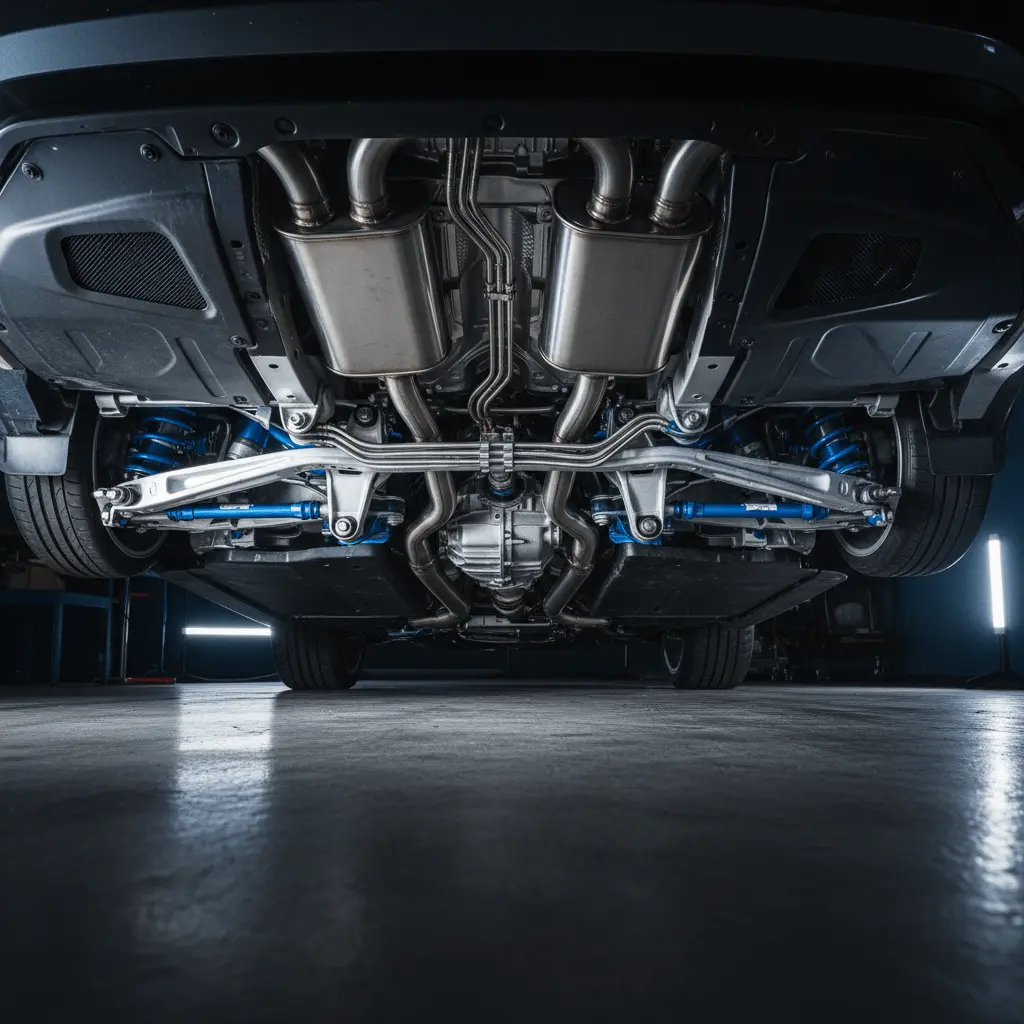
An undercarriage car wash is the best way to protect your vehicle. It helps your car last longer and saves you money on repairs. In this guide, we will share simple and easy ways to clean the underside of your car, whether you do it yourself or visit a car wash. By following these steps, you can keep your car safe from corrosion and dirt, and in great shape for years to come.
What is an Undercarriage Car Wash and Why It Matters
It is the bottom of your car. It touches the road every day and faces the most dirt and damage. An undercarriage car wash cleans this hidden part so your car stays in good shape and lasts longer.
Key Components
The bottom of the car has many important parts:
- Exhaust system: takes gases out of the engine
- Brake lines: help the brakes stop the car
- Fuel lines: carry fuel to the engine
- Suspension parts: keep the ride smooth and steady
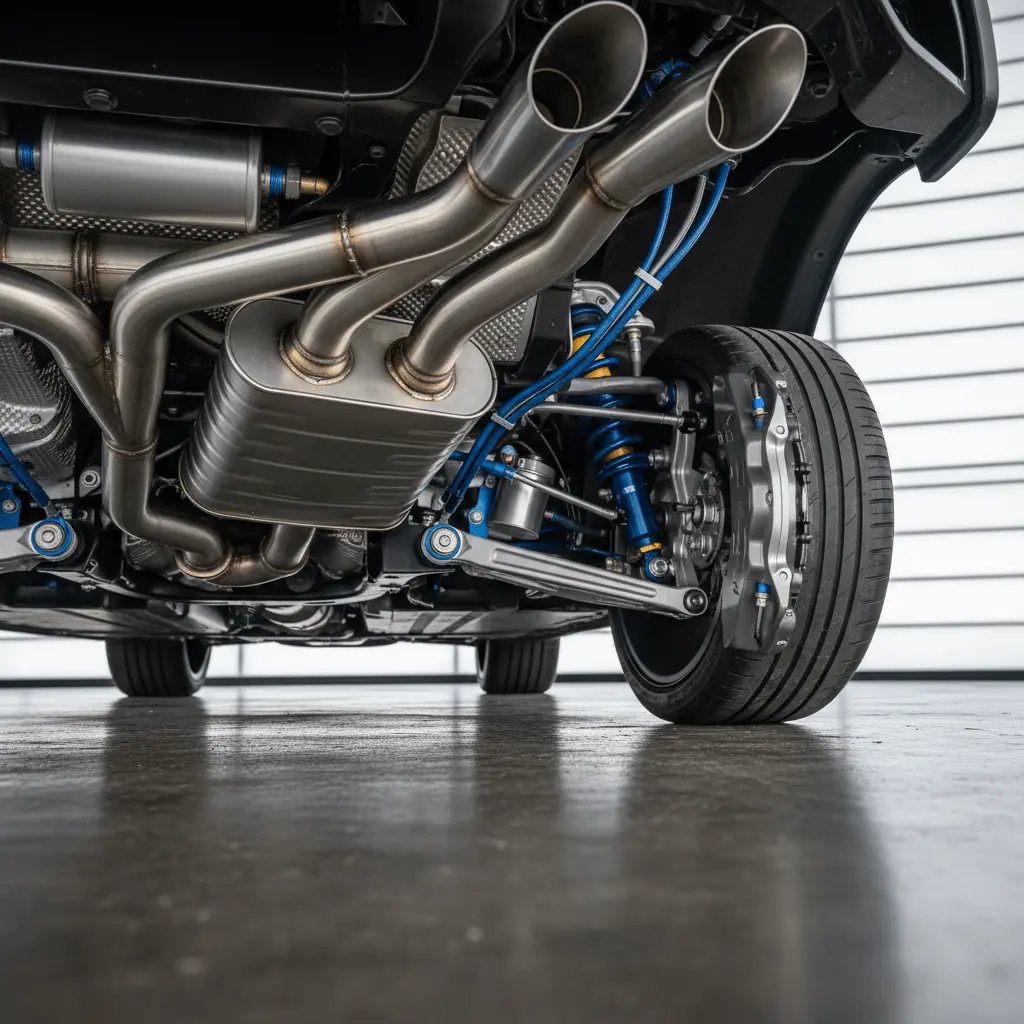
How an Undercarriage Wash Works
There are two common ways to wash the undercarriage:
- Drive-through car wash: Some washes have strong water jets under the floor. As you drive in, the sprays clean the bottom of your car in seconds.
- DIY wash: At home, you can use a garden hose or pressure washer. Spraying water underneath helps clear away the dirt and grime.
Why It Is Essential for Vehicle Health
Cleaning the undercarriage protects the car in many ways:
- Rust prevention: Water and salt can damage metal if not cleaned
- Safety: Clean brakes and fuel lines work more reliably
- Performance: Suspension and exhaust parts stay in better condition, helping the car drive smoothly
An undercarriage wash is a simple step that protects the hidden parts of your car and keeps it running strong for years.
Types of Undercarriage Car Washes
The bottom of a car, called the undercarriage, needs cleaning just like the outside. There are many ways to do it. Each type works in a different way.
Drive-Through Washes with Undercarriage Sprays
In a drive-through wash, the car moves through a tunnel. Water jets spray from below and wash the bottom. It is quick, easy, and does not need you to do anything.
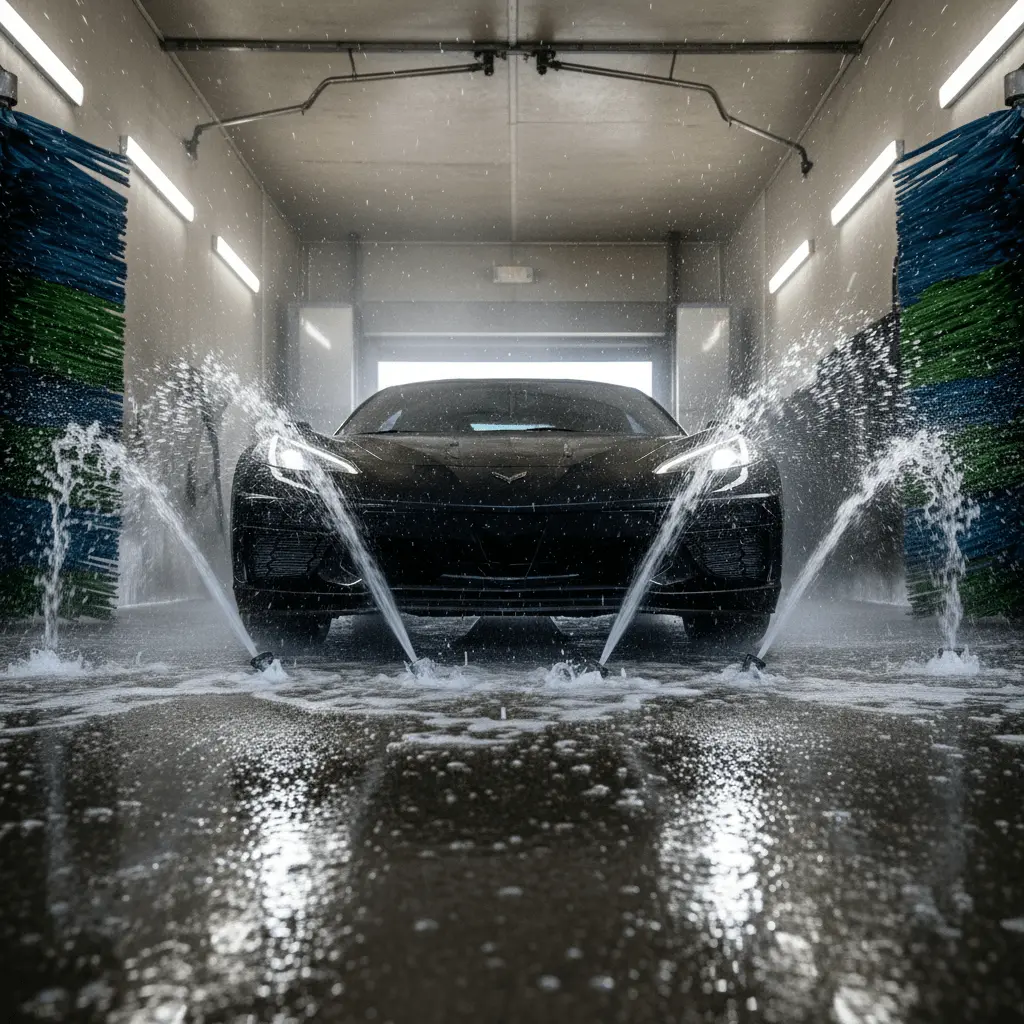
No-Touch Options
A touchless car wash uses only water and soap. No brushes touch the car. This is gentle on the paint and still strong enough to rinse the undercarriage.
Manual Pressure Washing
At some car wash stations, you can hold a pressure washer yourself. You spray under the car to remove mud or dirt. This way, you control where the water goes.
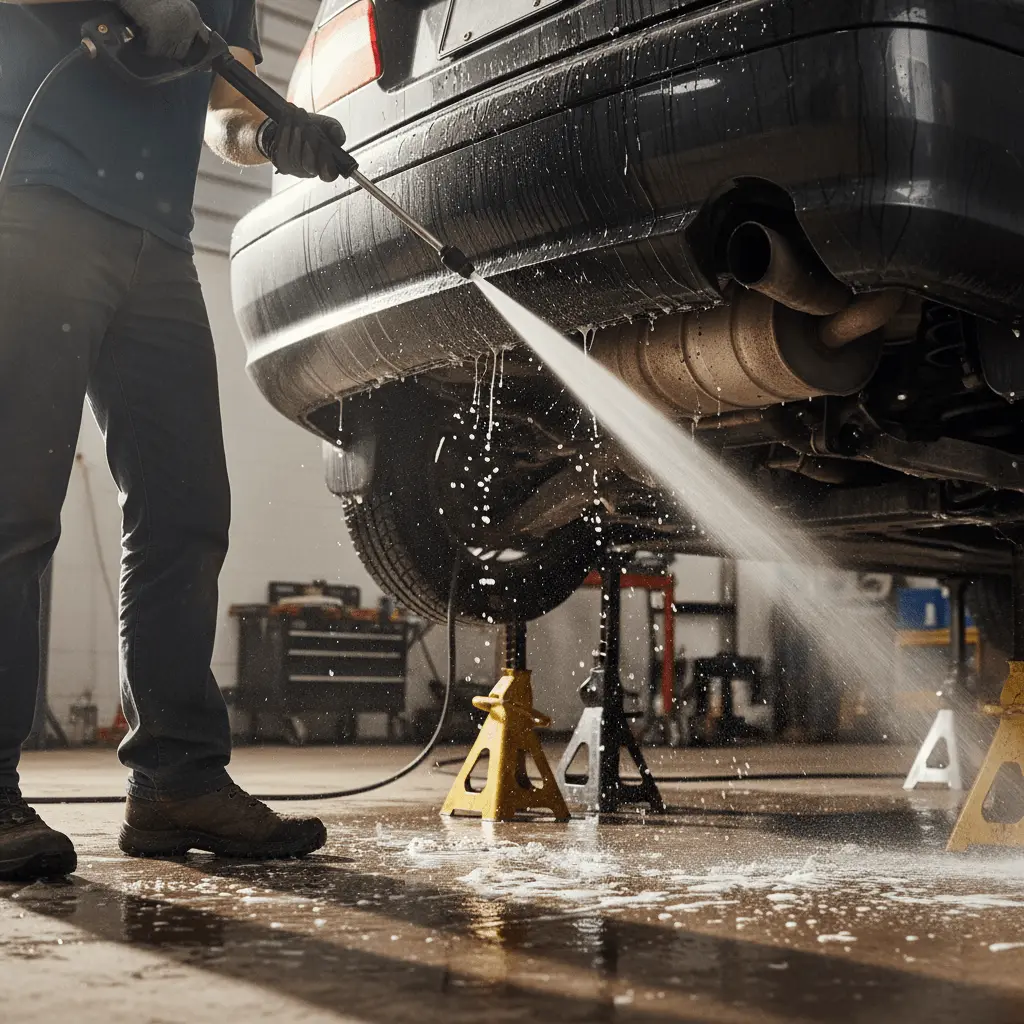
Professional Detailing Services
Detailing shops clean cars very carefully. They can lift the car up and wash every hidden part. This type of cleaning is the most complete but also costs more.
DIY Undercarriage Cleaning Kits
Some kits let you clean the underbody at home. They attach to a hose or washer and spray water under the car. These kits are useful if you want to clean often without visiting a car wash.
How to Wash Your Car Undercarriage at Home
Washing the bottom of your car at home is not hard if you have the right tools. A DIY undercarriage wash keeps your car safe and helps it last longer.
Tools and Equipment You Will Need
Here is what you should have ready:
- Pressure washer strong water spray for cleaning
- Cleaner attachment helps reach under the car
- Degreaser or car soap removes sticky dirt and oil
- Car ramps lift the car so you can reach the bottom
- Safety gloves and goggles to protect yourself
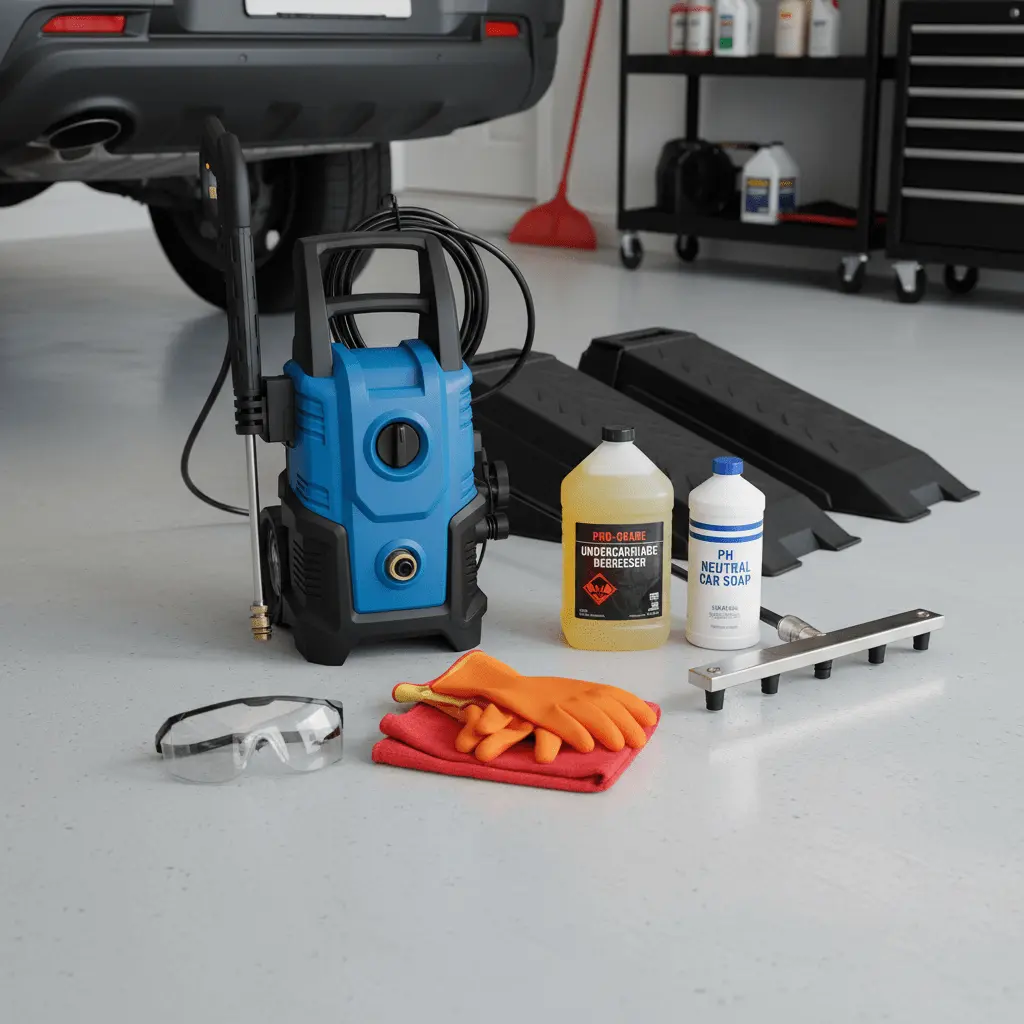
Step-by-Step Cleaning Process
Prepare your vehicle
Drive the car onto ramps or use a jack stand. This gives you space to clean under the car.
Rinse off dirt and debris
Use the pressure washer to spray away loose mud, dust, and dirt.
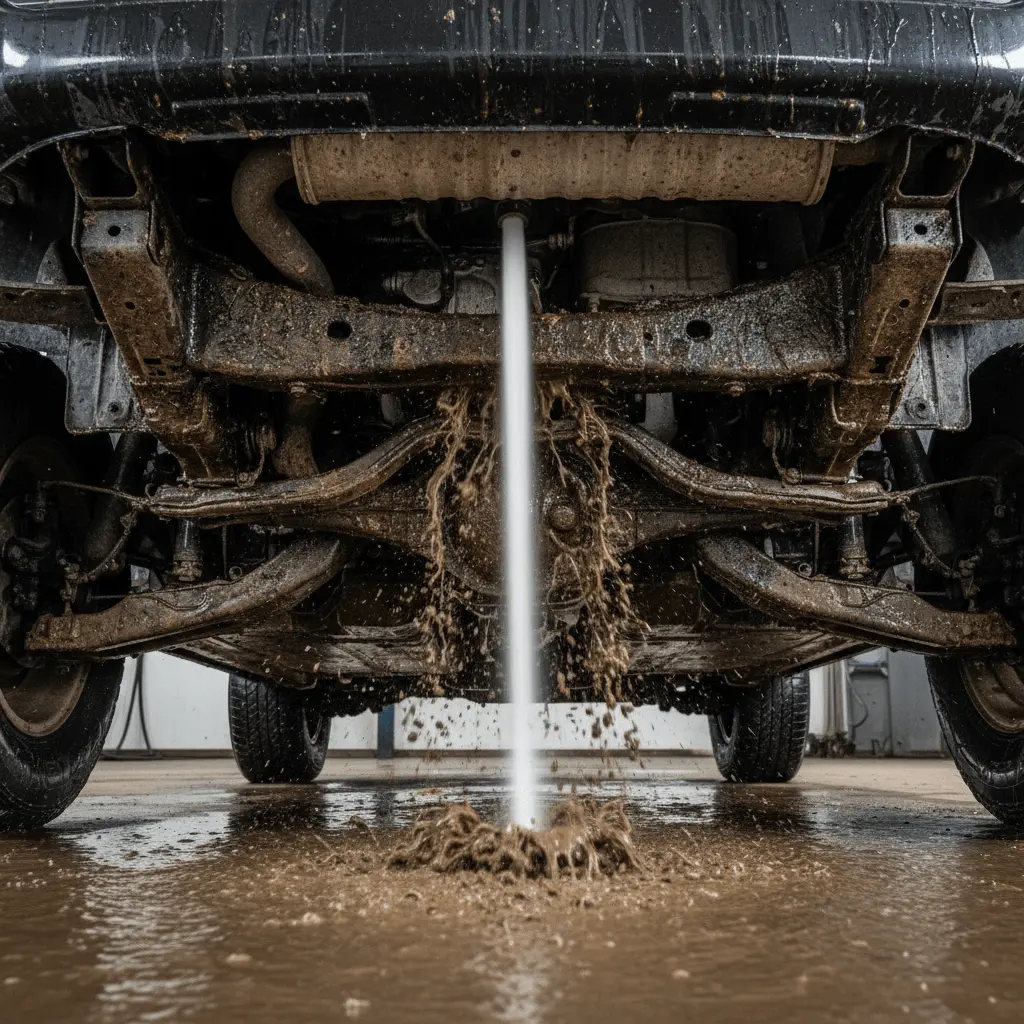
Apply cleaning solution
Spray soap or degreaser on the bottom. Let it sit for a few minutes so it can soften the grime.
Scrub problem areas
Use a long brush or the washer tool to scrub parts with heavy dirt or oil.
Final rinse
Spray clean water under the car to wash away soap and loosened dirt.
Dry thoroughly
Let the car dry in the air or wipe parts you can reach with a towel.
Apply protective coating (optional)
You can spray a special coating to protect the bottom from rust and salt.
Best Products for Undercarriage Cleaning
Cleaning the bottom of your car is easier if you use the right products. Here are some good options that help remove dirt, oil, and salt.
Chemical Guys Bare Bones Undercarriage Spray
This spray makes the bottom of the car look clean and shiny again. It also helps stop dust and dirt from sticking too quickly. Just spray it on after washing.
Meguiar’s D108 Super Degreaser
This cleaner is very strong and works well on greasy and oily spots. If your car bottom is very dirty, this product can handle it. You can also mix it with water for lighter cleaning.
Simple Green Pro HD Cleaner
This cleaner is safe to use on metal, rubber, and plastic parts. It is powerful but not harsh, which makes it a good choice for regular cleaning. Spray it on, wait a little, then rinse it off.
Karcher Pressure Washer Kit
This kit comes with tools that help clean under the car. The water spray is strong and can reach areas that normal hoses cannot. It is great for washing away stuck mud.
Ryobi Undercarriage Cleaner Attachment
This tool connects to a pressure washer. It rolls under the car and sprays water upward. It makes cleaning easier because you do not have to crawl under the car.
Autoglym Polar Blast Snow Foam
This foam covers the car with thick bubbles. The bubbles loosen dirt so it is easier to wash off later. It’s safe for the whole car, including the undercarriage.
Rust Prevention and Long-Term Protection
Rust that grows under a car can reduce its durability and safety. Here is how to understand and stop it.
How Rust Forms on the Undercarriage
Rust happens when metal, water, air, and road salt mix together. The bottom of the car touches all these things, so it is the first place where rust can start.
Early Signs of Rust Damage
Watch for these signs:
- Small brown or orange spots on metal
- Paint bubbling or peeling off
- Rough or flaky patches under the car
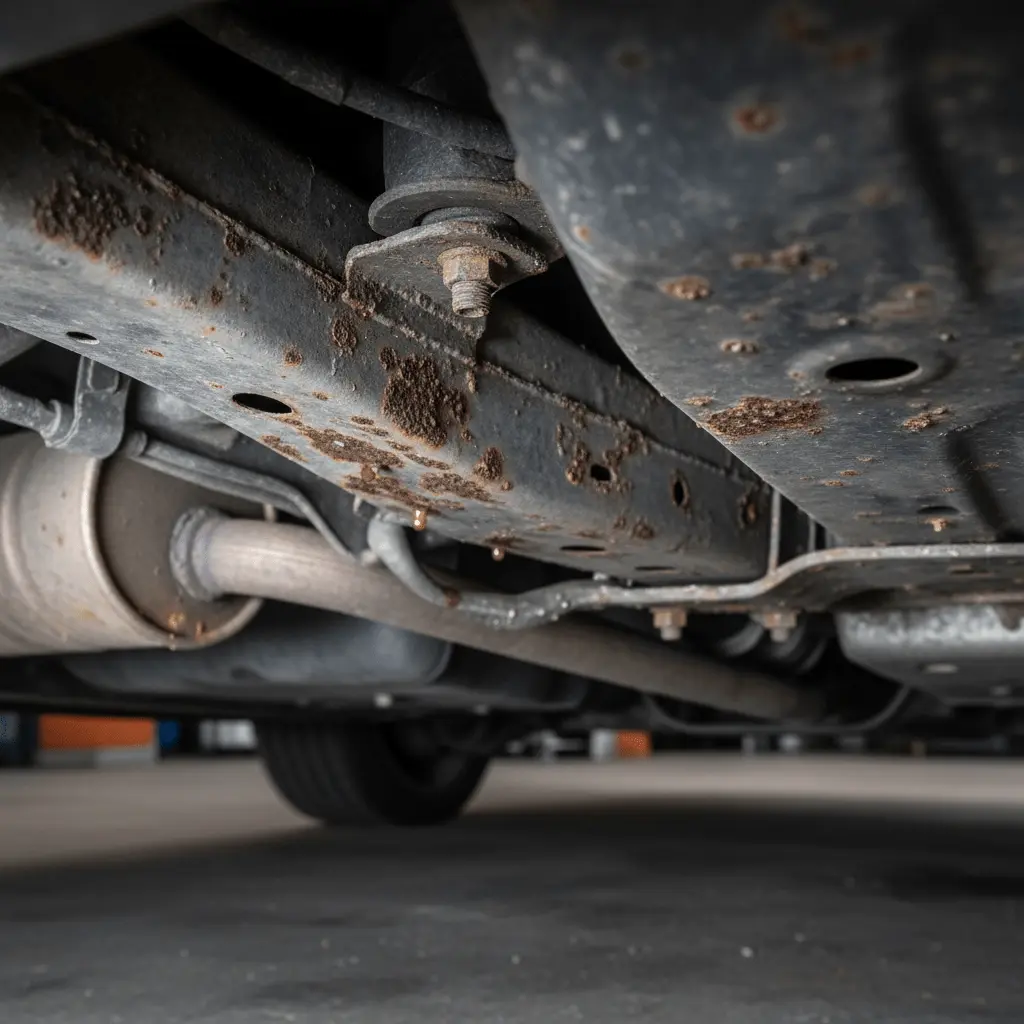
Finding these signs early makes it easier to fix.
Protection Options
You can protect your car in many ways:
- Krown undercoating: an oil spray that blocks water and salt.
- Ziebart rustproofing: a strong layer that keeps metal safe.
- Engine splash shields: covers under the engine that stop mud, water, and stones.
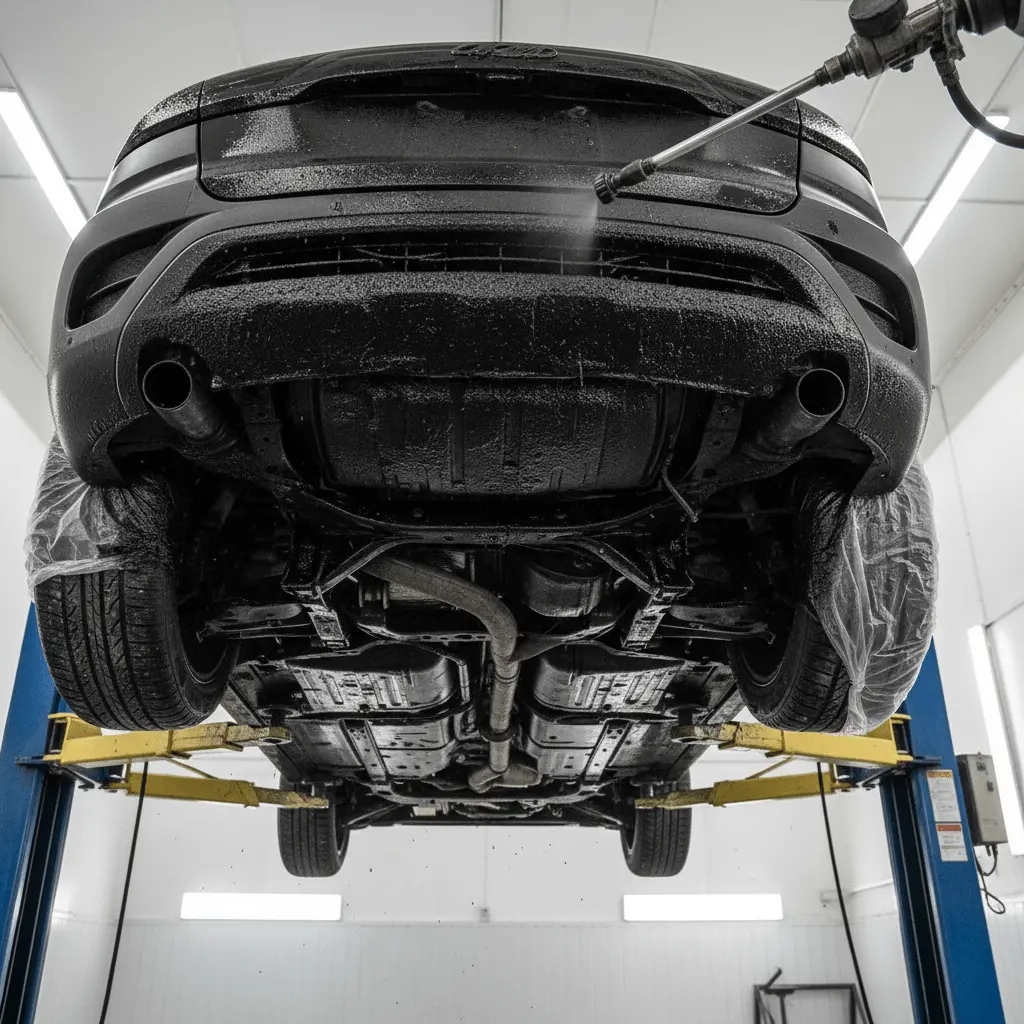
Seasonal Maintenance Tips
- Winter salt: wash the bottom of your car often during snowy months.
- Coastal driving: rinse the car if you live near the sea, because salty air can cause rust.
- Off-road care: clean under the car after mud or rocky roads, so dirt does not hold water.
Cost, Frequency, and Safety
Many people wonder how much an undercarriage wash costs, how often they need it, and if it is safe for their car. Here is a simple guide.
Typical Service Costs
- A basic undercarriage wash usually costs $5 to $15 at a car wash.
- If you go for a full service with cleaning and protection, it can be $30 to $50 or more.
- Doing it yourself at home is cheaper, but you may need to buy tools or cleaners.
How Often to Wash the Undercarriage
- Wash the undercarriage every 2 to 3 months for normal driving.
- If you drive in areas with snow, road salt, or near the sea, do it more often.
- After off-road or muddy trips, clean it right away to stop dirt and salt from sticking.
Safety Considerations for Different Vehicles
- Undercarriage washes are safe for most cars when done the right way.
- For older cars with loose parts, check before washing with strong water pressure.If you drive a truck or SUV, it is extra helpful since these vehicles face more dirt and mud.
- Always make sure the car is raised safely if you wash at home.
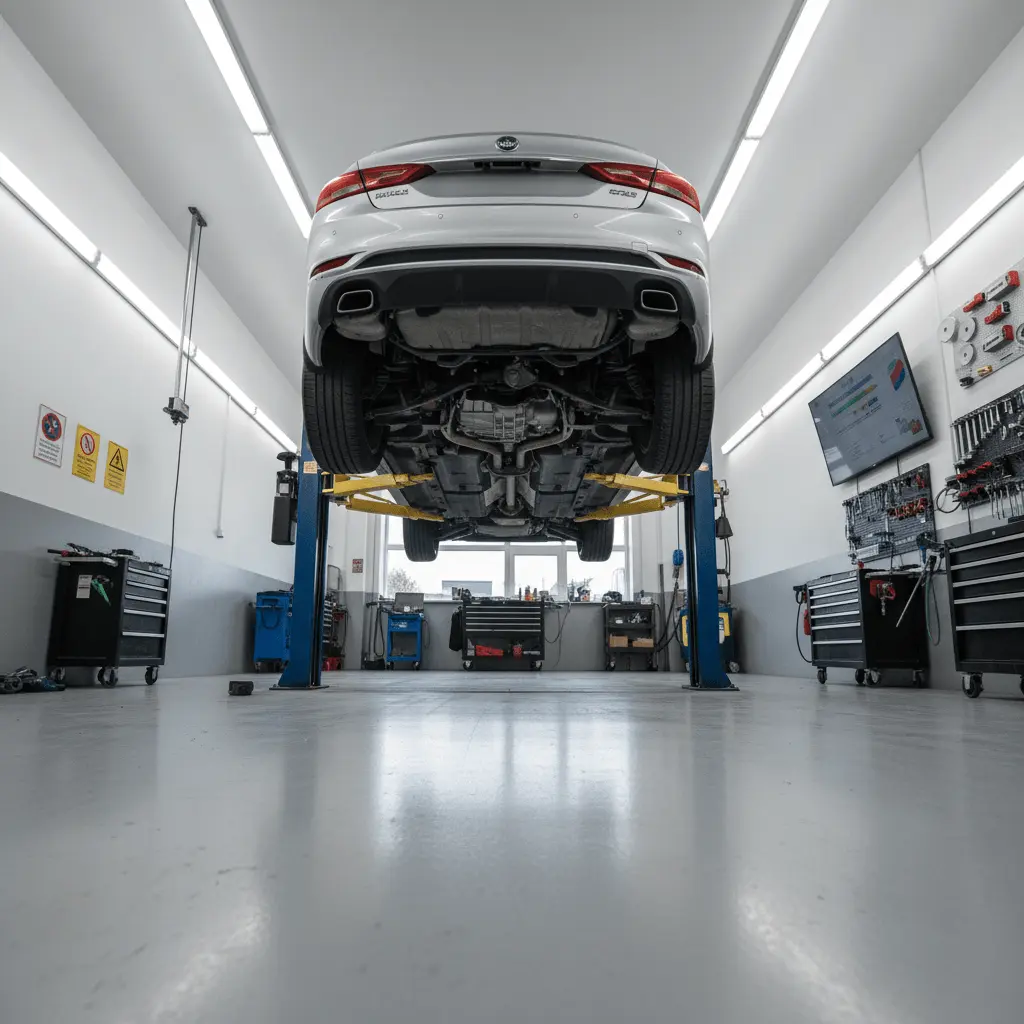
Automated Undercarriage Wash vs DIY
When it comes to cleaning the undercarriage, you can choose between an automated wash or doing it yourself. Both have pros and cons.
Automated Undercarriage Wash
These washes work best for daily city or highway driving. They are great for quick cleaning during routine car washes and save time when you can’t manage DIY cleaning.
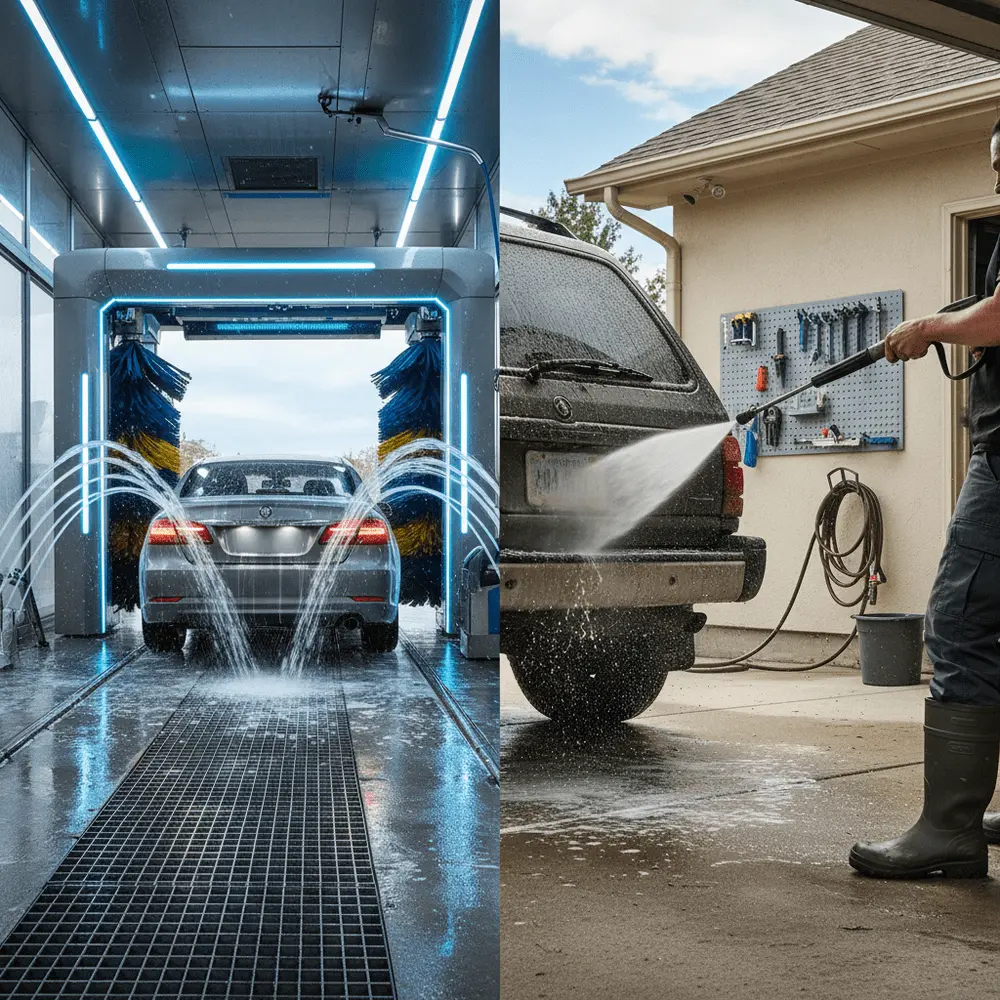
DIY Undercarriage Cleaning
DIY undercarriage cleaning is ideal after off-road trips with heavy mud. It is also a smart choice if you drive in snowy or coastal areas, helping with long-term rust prevention and car care.
| Feature | Automated Wash | DIY Cleaning |
|---|---|---|
| Time | Fast (minutes) | Slow (30-60 mins) |
| Effort | Very low | High |
| Cost | $5-$15 | Higher at first (tools), cheaper later |
| Deep Cleaning | Basic rinse | Very thorough |
| Best For | Quick, regular care | Detailed, long-term care |
Is it good to wash the undercarriage of your car?
Yes, it is very important. Washing the undercarriage helps remove salt, mud, and dirt that can cause rust and damage to metal parts over time.
How do you clean the undercarriage of a car?
First, rinse with water to remove loose dirt and mud. Then use a cleaner or soap spray to cover the bottom and wash away the stuck grime.
Do automatic car washes wash the undercarriage?
Yes, most automatic car washes include an undercarriage spray that blasts away dirt and salt before rinsing and drying the rest of your car.
How often should I wash my undercarriage?
Usually, four times a year is enough. But if you drive on muddy roads, snowy areas, or go off-road, aim for about six times a year.
